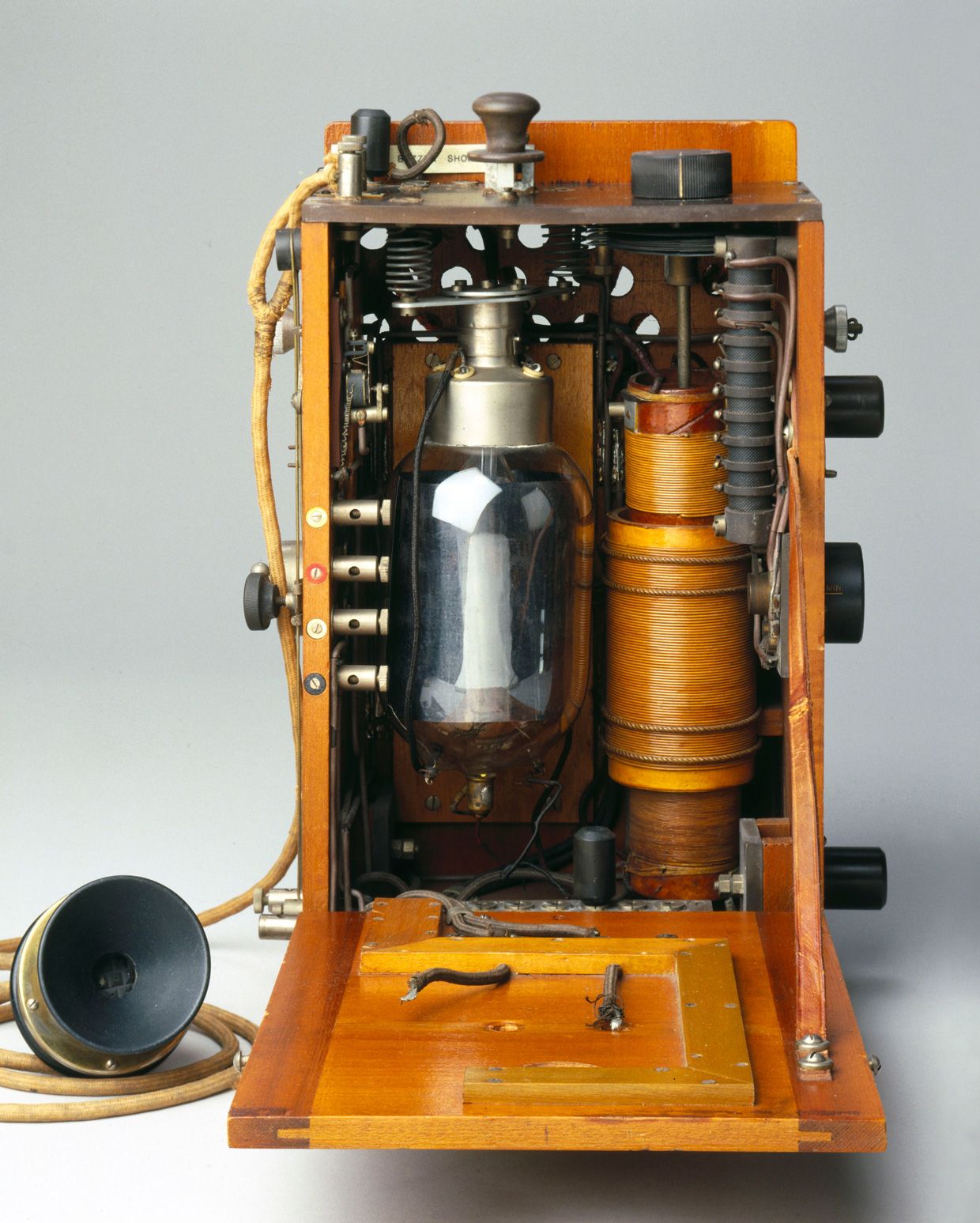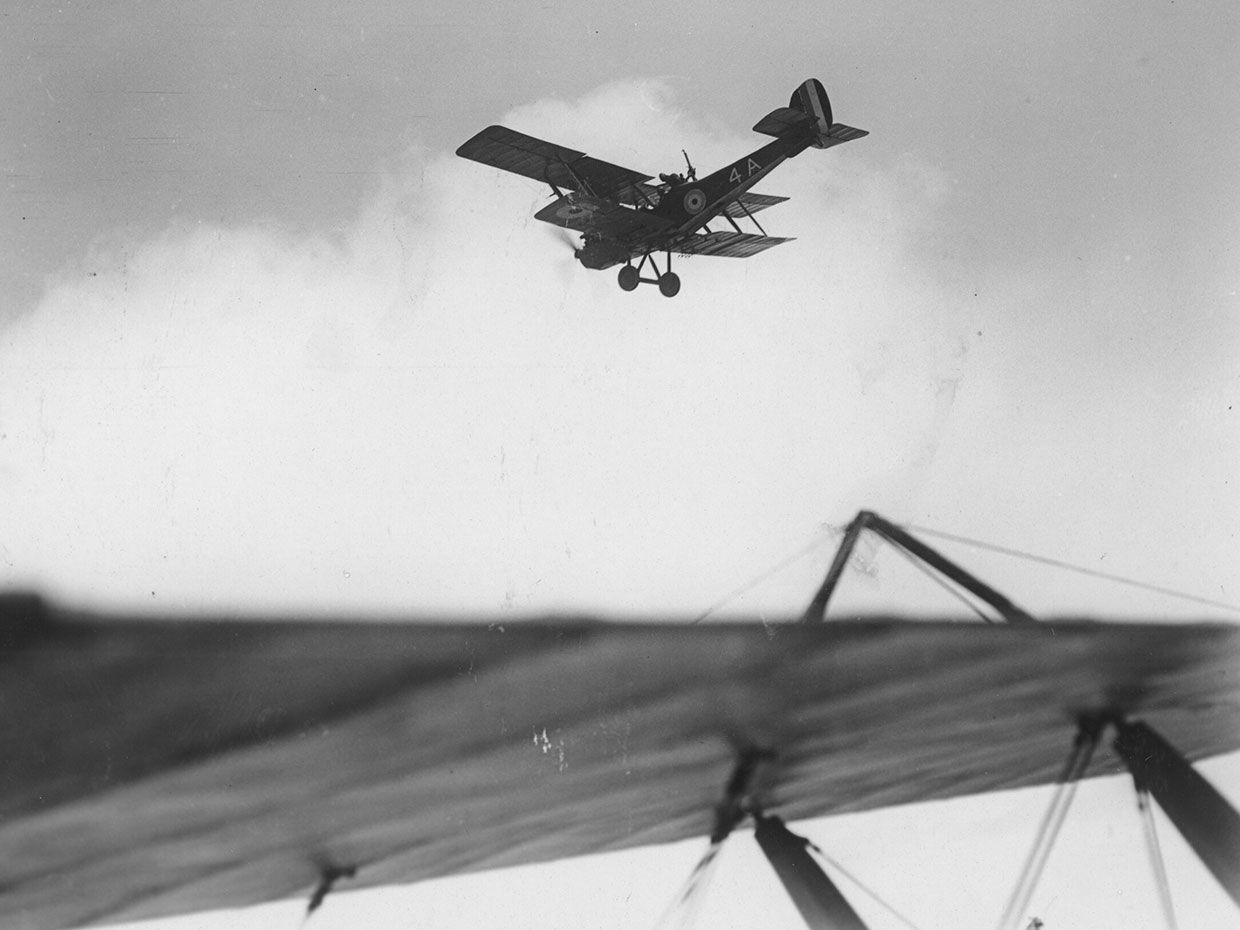In World War I, British Biplanes Had Wireless Phones in the Cockpit
 Photo: Science Museum/SSPL/Getty Images Marconi engineers serving in the British Royal Flying Corps developed this aerial telephony set.
Photo: Science Museum/SSPL/Getty Images Marconi engineers serving in the British Royal Flying Corps developed this aerial telephony set. As soon as the first humans went up in hot air balloons in the late 1700s, military strategists saw the tantalizing possibilities of aerial reconnaissance. Imagine being able to spot enemy movements and artillery from on high-even better if you could instantly communicate those findings to colleagues on the ground. But the technology of the day didn't offer an elegant way to do that.
By the early 20th century, all of the necessary elements were in place to finally make aerial reconnaissance a reality: the telegraph, the telephone, and the airplane. The challenge was bringing them together. Wireless enthusiasts faced reluctant government bureaucrats, who were parsimonious in funding an unproven technology.
Wireless Telegraphy Provided Vital Intel During World War I BattlesOne early attempt involved wireless telegraphy-sending telegraph signals by radio. Its main drawback was size. The battery pack and transmitter weighed up to 45 kilograms and took up an entire seat on a plane, sometimes overflowing into the pilot's area. The wire antenna trailed behind the plane and had to be reeled in before landing. There was no room for a dedicated radio operator, and so the pilot would have to do everything: observe the enemy, consult the map, and tap out coordinates in Morse code, all while flying the plane under enemy fire.
Despite the complicated setup, some pioneers managed to make it work. In 1911, First Lieutenant Benjamin D. Foulois, pilot of the U.S. Army's sole airplane, flew along the Mexican border and reported to Signal Corps stations on the ground by Morse code. Three years later, under the auspices of the British Royal Flying Corps (RFC), Lieutenants Donald Lewis and Baron James tried out air-to-air radiotelegraphy by flying 16 kilometers apart, communicating by Morse code as they flew.
It didn't take long for the RFC's wireless system to see its first real action. England entered World War I on 4 August 1914. On 6 September while flying during the first Battle of the Marne in France, Lewis spotted a 50-km gap in the enemy line. He sent a wireless message reporting what he saw, and British and French troops charged the gap. It was the first time that a wireless message sent from a British plane was received and acted upon. British army commanders became instant evangelists for wireless, demanding more equipment and training for both pilots and ground support.
From then on, the RFC, which had formed in 1912 under Captain Herbert Musgrave, grew quickly. Initially, Musgrave had been tasked with investigating a laundry list of war-related activities-ballooning, kiting, photography, meteorology, bomb-dropping, musketry, and communication. He decided to focus on the last. At the start of the war, the RFC took over the Experimental Marconi Station at Brooklands Aerodrome in Surrey, southwest of London.
 Photo: National Library of Scotland A British biplane on a reconnaissance mission flies over enemy lines in France during World War I.
Photo: National Library of Scotland A British biplane on a reconnaissance mission flies over enemy lines in France during World War I. Brooklands had been the site of the first powered flight in England, in 1909, even though it wasn't an ideal spot for an airfield. The runway sat in the middle of a motor racetrack, high-tension cables surrounded the field on three sides, and two 30-meter-tall brick chimneys stood to the east.
At first, reconnaissance pilots reported on the effectiveness of artillery firings by giving directional instructions. "About 50 yards short and to the right" was one message that Lewis sent at Marne. That's a fairly long string for a pilot to tap out in Morse code. By October 1914, the British had developed maps with grid references, which meant that with just a few letters and numbers, such as "A5 B3," you could indicate direction and distance. Even with that simplification, however, using radiotelegraphy was still cumbersome.
Voice Calls From the Cockpit Relied on Good MicrophonesDirect voice communication via wireless telephony was a better solution-except that the open cockpit of a biplane wasn't exactly conducive to easy conversation. Intense noise, vibration, and often-violent air disturbances drowned out voices. The muscles of the face had trouble retaining their shape under varying wind pressure. Pilots had difficulty being understood by crewmen sitting just a few centimeters away, never mind being heard through a microphone over a radio that had to distinguish voice from background noise.
In the spring of 1915, Charles Edmond Prince was sent to Brooklands to lead the development of a two-way voice system for aircraft. Prince had worked as an engineer for the Marconi Co. since 1907, and he and his team, many of whom also came from Marconi, soon got an air-to-ground system up and running.
Prince's system was not at all like a modern cellphone, nor even like the telephones of the time. Although the pilot could talk to the ground station, the ground operator replied in Morse code. It took another year to develop ground-to-air and machine-to-machine wireless telephony.
Prince's group experimented with a variety of microphones. Eventually they settled on an older Hunnings Cone microphone that had a thick diaphragm. Through trial and error, they learned the importance of testing the microphone outside the laboratory and under typical flight conditions. They found it almost impossible to predict how a particular microphone would work in the air based solely on its behavior on the ground. As Prince later wrote about the Hunnings Cone, "it appeared curiously dead and ineffective on the ground, but seemed to take on a new sprightliness in the air."
The diaphragm's material was also important. The team tested carbon, steel, ebonite, celluloid, aluminum, and mica. Mica was the ultimate winner because its natural frequency was the least affected by engine noise. (Prince published his findings after the war, in a 1920 journal of the Institution of Electrical Engineers (IEE). If you have a subscription to IEEE Xplore, you can read Prince's paper here [PDF].)
Prince was an early proponent of vacuum tubes, and so his radio relied on tubes rather than crystals. But the tubes his team initially used were incredibly problematic and unreliable, and the team worked through several different models. After Captain H.J. Round of the Marconi Co. joined Prince's group, he designed vacuum tubes specifically for airborne applications.
During the summer of 1915, Prince's group successfully tested the first air-to-ground voice communication using an aircraft radio telephony transmitter. Shortly thereafter, Captain J.M. Furnival, one of Prince's assistants, established the Wireless Training School at Brooklands. Every week 36 fighter pilots passed through to learn how to use the wireless apparatus and the art of proper articulation in the air. The school also trained officers how to maintain the equipment.
Hands-Free Calling Via the Throat MicrophonePrince's team didn't stop there. In 1918, they released a new aviator cap that incorporated telephone receivers over the ears and a throat microphone. The throat mic was built into the cap and wrapped around the neck so that it could pick up the vibrations directly from the pilot's throat, thus avoiding the background noise of the wind and the engine. This was a significant advancement because it allowed the pilots to go "hands free," as Captain B.S. Cohen wrote in his October 1919 engineering report.
By the end of the war, Prince and his engineers had achieved air-to-ground, ground-to-air, and machine-to-machine wireless speech transmission. The Royal Air Force had equipped 600 planes with continuous-wave voice radio and set up 1,000 ground stations with 18,000 wireless operators.
This seems like a clear example of how military technology drives innovation during times of war. But tracing the history of the achievement muddies the water a bit.
In the formal response to Prince's 1920 IEE paper, Captain P.P. Eckersley called the airplane telephone as much a problem of propaganda as it was a technical challenge. By that, he meant Prince didn't have an unlimited R&D budget, and so he had to prove that aerial telephony was going to have practical applications.
In his retelling of the development, Prince was proud of his team's demonstration for Lord Kitchener at St. Omer in February 1916, the first practical demonstration of the device.
But Major T. Vincent Smith thought such a demonstration was ill-advised. Smith, a technical advisor to the RFC, argued that showing the wireless telephone to the higher command would only inflame their imaginations, believing such a device could solve all of their considerable communication difficulties. Smith saw it as his duty to dampen enthusiasm, lest he be asked to "do all sorts of impossible things."
Both Round, the vacuum tube designer, and Harry M. Dowsett, Marconi's chief of testing, added nuance to Prince's version of events. Round noted that investigations into vacuum-tube systems for sending and receiving telephony began in 1913, well before the war was under way. Dowsett said that more credit should be given to the Marconi engineers who created the first working telephony set (as opposed to Prince's experimental set of 1915).
In his 1920 article, Prince acknowledges that he did not include the full history and that his contribution was the novel application of existing circuitry to use in an airplane. He then gives credit to the contributions of Round and other engineers, as well as the General Electric Co., which had patented a similar aerial telephony system used by the U.S. Army Signal Corps.
History rarely has room for so much detail. And so it is Prince-and Prince alone-who gets the credit line for the aerial telephony set that is now in the collections of the Science Museum London. It's up to us to remember that this innovative machine was the work not of one but of many.
An abridged version of this article appears in the April 2020 print issue as "Calling From the Cockpit."
Part of a continuing series looking at photographs of historical artifacts that embrace the boundless potential of technology.
About the AuthorAllison Marsh is an associate professor of history at the University of South Carolina and codirector of the university's Ann Johnson Institute for Science, Technology & Society.